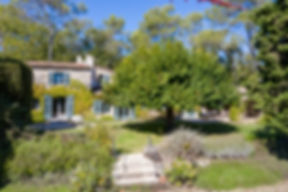

History
The beautiful ‘Bastide des Bruisses’ stands on a one hectare private estate with centuries-old trees, layered by terraces. These ‘restanques’ were constructed by Roman veterans to ensure a better harvest and protect the land from erosion. The retired warlords were allowed to live on estates like these as a reward for their loyal service. They lived off the produce cultivated on the terraces, such as wheat, vines and vegetables. To this day, the garden has olive, fig and other fruit trees. Irises, poppies, fragrant herbs, colorful roses and oleanders bloom in season.
The name 'Bruisses' means 'effervescent sounds' and refers to the adjacent stream. The Bastide has its own road and is neighboring a primeval forest. Former resident ‘Baron de Breuverie de Valbonne’ built a well for the source underneath the property. Nowadays guests can enjoy the pure and soft spring water in the luxury turquoise swimming pool. The archbishop, brother of the Baron, lived in the monastery next door with his monks, which is now the home of ‘Golf de la Bégude’.
Bastide des Bruisses was a Roman ‘villa rustica’; a gentlemen’s farm with goat stables, which now houses luxurious rooms. Everything has been architecturally restored. The thick walls date from 1000-1200, they represent the Romanesque style similar to the cathedral in Vence. The exterior wall is made from southern French natural stone commonly referred to as ‘pierres en taille’ and is covered with ivy in the summer.
The independent guest house can be found at a comfortable distance from the main house. The estate even has a prayer chapel for the crusaders and Compostella pilgrims of that time. In short, welcome to paradise.
Within walking distance lies the authentic medieval village of Valbonne, shaped in a typical rectangular structure like a Roman army camp. The central square has lovely restaurants with al fresco terraces and on Fridays this is the venue of the popular farmers market.
Deriving its name from the Latin term 'vallis bona' meaning beautiful valley, Valbonne was given city rights by the Bishop of Antibes in 1199. Its center originally had six city gates, which unfortunately are no longer present. In 1351 the majority of the population in Valbonne died from the plague. The village was rebuilt in 1519 by Italian immigrants from Calabria and the monks of 'Iles de Lérins', the islands in front of Cannes. In ancient times, medieval knights, monks, Cathars and Templars lived in the surrounding ancient villages of Mougins, Opio, Gourdon, St Paul de Vence and Biot.
This inspiring region with beautiful summers and mild winters has attracted many renowned artists including Edith Piaf, Charles Aznavour, Picasso, Renoir, Matisse, and Chagall. To this day, due to international events such as the Cannes Film Festival and the Monaco Grand Prix, the French Riviera remains a playground for the rich and famous…